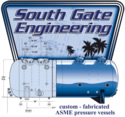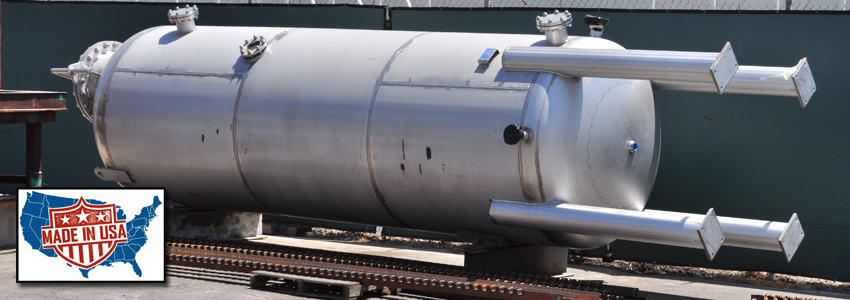 |
 |
 |
| Home | Products | Services | Facility Description | Our Catalog | Photo Gallery | Who We Are | Contact |
Blow Down and Expansion Tanks
|
Blow Down Tanks Durability, safety, and quality are the passwords to the South Gate Engineering Boiler Blowdown Tank. Durability has been achieved through a standard design that incorporates a concentric wear plate and a tangential blowdown inlet. Safety and quality are assured by 35 years of experience in manufacturing A.S.M.E. certified pressure vessels.
In many areas, Boiler Blowdown tanks are required by law to reduce the temperature and pressure of blowdown from the boiler before it enters the sewer system. These laws should be carefully reviewed before designing the blowdown system. It is generally accepted that the temperature of the water leaving the blowdown equipment shall not exceed 150 degrees F. and 5 psig.
Standard blowdown tanks manufactured to A.S.M.E. code specifications are available and comply with the criteria outlined below for National Board registration except for requirement #2. The minimum shell and head thickness will be designed as required by Section VIII, Division 1 of the A.S.M.E. Code. If specification requirements require a shell thicker than what is required by Code, please consult the factory. National Board Vessels designed and constructed in accordance with the National Board of Boilers and Pressure Vessel Inspectors specifications must meet the following requirements: 1. The blowdown tank shall be designed in accordance with Section VIII, Division 1 of the A.S.M.E. Code for a working pressure 1/4 the maximum working pressure of the boiler. 2. The shell and head thickness shall be 3/8" minimum. 3. A pressure gage shall be installed and graduated to read 0 to 25 PSI. 4. A thermometer well shall be located close to the water outlet connection and in contact with the retained water within the tank. 5. The blowdown tank volume shall be equal to twice the volume of water removed from the boiler when the normal water level within the boiler is reduced at least 4". 6. The blowdown tank outlet shall be controlled such that it remains half full of water after each blowdown cycle. The above criteria are for blowdown tanks connected to boilers operating at less than 399 PSI. For systems operating at higher pressures, or requiring multiple units, please consult the factory for sizing and pricing. Operation Boiler blowdown is piped directly to the tangential inlet in the blowdown tank. By using an inlet, two purposed are satisfied: 1. The entering blowdown begins a swirling action that increases mixing with the cold water in the lower portion of the tank. 2. The rapid erosion of the shell familiar to a perpendicular inlet is greatly reduced by the tangential entry of the blowdown and the standard wear plate provided on all South Gate Engineering blowdown tanks. Since the blowdown tank is vented to the atmosphere, the incoming condensate, which has been maintained in the liquid state due to the high system pressure, flashes to steam and is partially released into the atmosphere. The remaining high temperature condensate is mixed with cold water in the lower portion of the blowdown tank. Due to the static layering of the water, it is necessary to use a dip tube on the outlet connection of the tank. This arrangement assures that only cold water is discharged into the sewer. In the event the outlet temperature is still excessive, additional cooling units such as heat exchangers or water mixing devices, as shown in the proceeding figures, should be considered. Tank Sizing Guide:
Markets Served: Dairy Hospital Hospitality HVAC Petroleum |
||
Expansion Tanks Open Type Expansion Tanks Open type expansion tanks are utilized in heating and/or chilled water-cooling systems as a buffer for the thermal expansion and contraction of the heated or cooled water. Open type Expansion Tanks must be located at the highest point of each circulating zone to maintain a flooded system. Special controls are used to maintain the proper water level within the tank. In addition, the design of open expansion tanks shall include aindoor overflow and vent from the upper portion of the tank. Generally, the indoor overflow is carried within the building to a suitable plumbing fixture of basement. Closed Type Expansion Tanks Closed Expansion Tanks are used in hot water systems to allow for the thermal expansion of hot water. Without a closed expansion tank, the increase in pressure created by the elevated temperature of the hot water would cause periodic releasing of the pressure relief valve. Two types of hot water systems require this application, closed loop systems, and hot water supply systems using a check valve or pressure reducing valve in the cold water inlet line. Specifying closed Expansion Tanks conforming to the A.S.M.E. boiler and pressure vessel code require different design pressure based on the system application. Expansion tanks used on closed loop hot water systems must be designed for a working pressure two-thirds (2/3) greater than the system operating pressure. Expansion tanks used in hot water supply systems with a check valve or pressure reducing valve located in the cold water inlet line need only be designed for a working pressure equal to the design pressure of the hot water heater. The volume for closed expansion tanks is calculated the same for both types of systems. The following formula is used to calculate this capacity: Vt = ((.0041 x T - .0466) x Vs)/((Pa/Pf)-(Pa/Po)) Vt = Minimum Volume of Expansion Tank(s) (gallons) All standard closed expansion tanks are provided with the necessary tappings for gauge glass assemblies, air charge fittings, and relief valves. These items of trim are available for packaging with the tank upon request. Tank Sizing Guide:
Markets Served:
|
South Gate Engineering warranty information available by clicking here. |
(C) 2012 South Gate
Engineering 13477 Yorba Ave, Chino, CA 91710, Phone: 909.628.2779 Fax: 909.628.6779 |